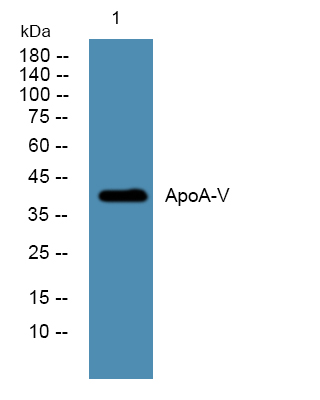ApoA-V Polyclonal Antibody
- Catalog No.:YT0269
- Applications:WB;ELISA
- Reactivity:Human;Rat;Mouse;
- Target:
- ApoA-V
- Fields:
- >>PPAR signaling pathway
- Gene Name:
- APOA5
- Protein Name:
- Apolipoprotein A-V
- Human Gene Id:
- 116519
- Human Swiss Prot No:
- Q6Q788
- Mouse Swiss Prot No:
- Q8C7G5
- Immunogen:
- Synthesized peptide derived from ApoA-V . at AA range: 30-110
- Specificity:
- ApoA-V Polyclonal Antibody detects endogenous levels of ApoA-V protein.
- Formulation:
- Liquid in PBS containing 50% glycerol, 0.5% BSA and 0.02% sodium azide.
- Source:
- Polyclonal, Rabbit,IgG
- Dilution:
- WB 1:500 - 1:2000. ELISA: 1:5000. Not yet tested in other applications.
- Purification:
- The antibody was affinity-purified from rabbit antiserum by affinity-chromatography using epitope-specific immunogen.
- Concentration:
- 1 mg/ml
- Storage Stability:
- -15°C to -25°C/1 year(Do not lower than -25°C)
- Other Name:
- APOA5;RAP3;Apolipoprotein A-V;Apo-AV;ApoA-V;Apolipoprotein A5;Regeneration-associated protein 3
- Observed Band(KD):
- 41kD
- Background:
- The protein encoded by this gene is an apolipoprotein that plays an important role in regulating the plasma triglyceride levels, a major risk factor for coronary artery disease. It is a component of high density lipoprotein and is highly similar to a rat protein that is upregulated in response to liver injury. Mutations in this gene have been associated with hypertriglyceridemia and hyperlipoproteinemia type 5. This gene is located proximal to the apolipoprotein gene cluster on chromosome 11q23. Alternatively spliced transcript variants encoding the same protein have been identified. [provided by RefSeq, Oct 2009],
- Function:
- caution:It is uncertain whether Met-1 or Met-4 is the initiator.,disease:Defects in APOA5 are a cause of hyperlipoproteinemia type 5 [MIM:144650]. Hyperlipoproteinemia type 5 is characterized by increased amounts of chylomicrons and very low density lipoprotein (VLDL) and decreased low density lipoprotein (LDL) and high density lipoprotein (HDL) in the plasma after a fast. Numerous conditions cause this phenotype, including insulin-dependent diabetes mellitus, contraceptive steroids, alcohol abuse, and glycogen storage disease type 1A (GSD1A) [MIM:232200].,disease:Defects in APOA5 are a cause of susceptibility to familial hypertriglyceridemia [MIM:145750]. It is a coronary heart disease risk factor. On a regular diet the patient demonstrates increased plasma VLDL. Plasma triglycerides are persistently increased, while plasma cholesterol and phospholipids are usually within normal limits.
- Subcellular Location:
- Secreted . Early endosome . Late endosome . Golgi apparatus, trans-Golgi network . In the presence of SORL1, internalized to early endosomes, sorted in a retrograde fashion to late endosomes, from which a portion is sent to lysosomes and degradation, another portion is sorted to the trans-Golgi network. .
- Expression:
- Liver and plasma.
- June 19-2018
- WESTERN IMMUNOBLOTTING PROTOCOL
- June 19-2018
- IMMUNOHISTOCHEMISTRY-PARAFFIN PROTOCOL
- June 19-2018
- IMMUNOFLUORESCENCE PROTOCOL
- September 08-2020
- FLOW-CYTOMEYRT-PROTOCOL
- May 20-2022
- Cell-Based ELISA│解您多样本WB检测之困扰
- July 13-2018
- CELL-BASED-ELISA-PROTOCOL-FOR-ACETYL-PROTEIN
- July 13-2018
- CELL-BASED-ELISA-PROTOCOL-FOR-PHOSPHO-PROTEIN
- July 13-2018
- Antibody-FAQs
- Products Images

- Western blot analysis of lysates from A431 cells, primary antibody was diluted at 1:1000, 4°over night



